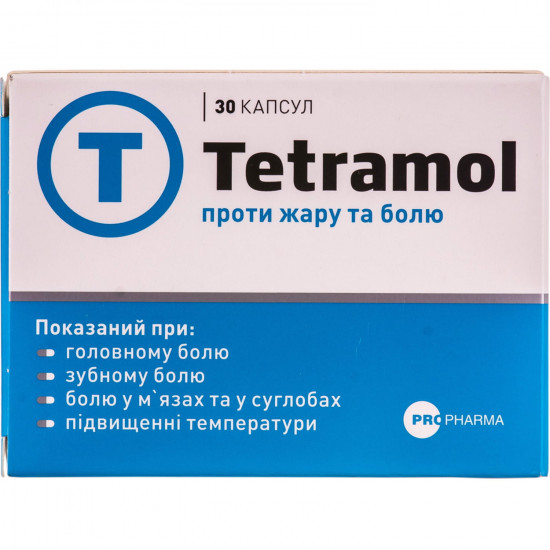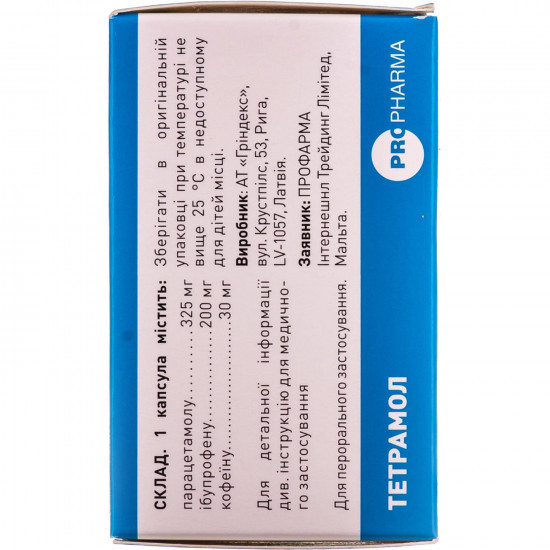



- Stock: In Stock
- Model: 177984
0% Customers recommend this product
-
5 Awesome0%
-
4 Great0%
-
3 Average0%
-
2 Bad0%
-
1 Poor0%
Reviews Over Tetrapier kaps. No. 30
- (0)
Total Reviews (0)
click here write review to add review for this product.
Report this review.
Description
Pharmacological properties
Pharmacodynamics. the combined medicine which effect is caused by the components which are its part. medicine renders analgeziruyushchy (anesthetic), anti-inflammatory, febrifugal action. synthesis of prostaglandins oppresses. reduces severity of a joint pain at rest and at the movement, reduces morning constraint and a swelling of joints, promotes increase in volume of movements.
Kofein strengthens analgeziruyushchy action of an ibuprofen and paracetamol, increases working capacity, reduces fatigue and drowsiness.
Pharmacokinetics. Paracetamol quickly and almost is completely soaked up in a GIT. The C max in blood plasma is reached in 30–60 min. after reception, and the T ½ makes 1–4 h after application of therapeutic doses. In case of a heavy liver failure it increases to 5 h. In a renal failure of T ½ does not increase, however, as removal by kidneys is limited, the dose of paracetamol needs to be lowered.
Paracetamol gets through GEB and also into breast milk.
Ibuprofen after reception is quickly absorbed byin a digestive tract. The C max in blood plasma is reached in 45 min. after reception, in synovial fluid — in 3 h after reception. The ibuprofen is metabolized in a liver, removed by kidneys in not changed look and in the form of metabolites. The t ½ — about 2 h
caffeine is quickly soaked up byAfter oral administration. The C max in blood plasma are reached approximately in 20–60 min., T ½ — about 4 h
Indication
Pain syndrome of various intensity: dysmenorrhea and menstrual pain; headache; neuralgia; myalgia; arthralgia; toothache. fervescence (fever at flu and catarrhal diseases). as a part of complex treatment of postoperative pain, reduction of expressiveness of symptoms of a pseudorheumatism and osteoarthritis.
Use
to Adults and teenagers is aged more senior than 16 years to accept 1–2 capsules each 4–6 h depending on intensity of a pain syndrome and the recommendation of the doctor. the daily dose should not exceed 6 capsules. to children aged from 12 up to 16 years: on 1 capsule 1–2 times a day. the capsule should be accepted without chewing, washing down with enough liquid (glass of water). usually duration of treatment is 3–7 days. if during this time there does not occur improvement, it is necessary to reconsider treatment.
Maximum term of application for children without consultation of the doctor — 3 days. The interval between receptions makes not less than 4 h. Not to exceed the recommended dose.
Contraindication
Hypersensitivity to paracetamol, an ibuprofen, caffeine or to any other component of medicine, stomach ulcer, including in the anamnesis (2 and more accurate an episode of exacerbation of an ulcer of a GIT or bleeding), bleeding in upper parts of a digestive tract or break in the anamnesis, connected with the previous treatment npvp; sharp pancreatitis, heavy abnormal liver functions and/or kidneys, a congenital hyperbilirubinemia, deficiency glyukozo-6-fosfatdegidrogenazy, alcoholism, blood diseases, the expressed anemia, a leukopenia, thrombosis, thrombophlebitis, at conditions of overexcitement; sleep disorder; heavy ag; organic diseases of a cardiovascular system; glaucoma; epilepsy, a hyperthyroidism, dekompensirovanny heart failure, violations of warm conductivity, heavy atherosclerosis, tendency to an angiospasm, ibs, a prostatauxe, severe forms of diabetes, allergic reaction (for example, oh, rhinitis, a Quincke's edema) after use of acetylsalicylic acid or others npvp, use of medicine along with npvp, advanced age.
not to applyalong with MAO, TsOG-2 inhibitors and within 2 weeks after the termination of their application; contraindicated to the patients accepting tricyclic antidepressants or blockers of β-adrenoceptors. Gilbert's syndrome. Age up to 12 years.
Side effectsFollowing side reactions on medicine are distributed by
according to meddra terminology.
General violations: hypersensitivity in the form of urticaria and an itch; heavy hypersensitivity reactions with such manifestations: edema of face, language and throat, short wind, tachycardia, arrhythmia, decrease or increase in the ABP, anaphylaxis, Quincke's edema, gepatorenalny syndrome, aggravation OH and bronchospasm.
from the system of blood and lymphatic system: blood formation violations, the Agranulocytosis, anemia (including hemolytic and aplastic), decrease in a hematocrit and level of hemoglobin, a sulfhemoglobinemia and a methemoglobinemia (cyanosis, short wind, heartaches), a leukopenia, a neutropenia, a pancytopenia, thrombocytopenia. The first signs are: high temperature, a sore throat, ulcers in oral cavities, flu symptoms, a severe form of exhaustion, inexplicable bleeding and bruises.
Gastrointestinal violations: abdominal pain, heartburn, stomacace, dyspepsia and nausea; diarrhea, meteorism, lock and vomiting, pancreatitis, duodenitis, esophagitis; a peptic ulcer, perforation or gastrointestinal bleeding which can lead in certain cases to a lethal outcome, especially at elderly people; exacerbation of ulcer colitis and Crohn's disease.
from an urinary system: OPN; renal colic; papillonekroz, especially at prolonged use, it is connected with the increased urea content in blood plasma, and swelled; cystitis; hamaturia; interstitial nephrite; nephrotic syndrome; oliguria; polyuria; tubular necrosis, glomerulonephritis; aseptic pyuria.
Neurologic violations: headache, dizziness, irritability, nervousness, depression, drowsiness, insomnia, uneasiness, psychomotor excitement, emotional instability, spasms; aseptic meningitis.
from sense bodys: hearing disorder, decrease in hearing, ring or sonitus, illegibility of sight, change of perception of flowers, toxic amblyopia.
from a respiratory system: a bronchospasm at the patients sensitive to aspirin and other NPVP.
from an endocrine system and metabolism: a hypoglycemia, up to a hypoglycemic coma; loss of appetite; dryness of mucous membranes of eyes and oral cavity; rhinitis.
from digestive system: violations from a liver; increase in activity of liver enzymes, as a rule, without development of jaundice; gepatonekroz (dose-dependent effect), liver failure.
from the immune system: at patients with autoimmune disorders (system lupus erythematosus, a general disease of connective tissue) during treatment the ibuprofen observed isolated cases of emergence of symptoms of aseptic meningitis, namely: stiff necks, headache, nausea, vomiting, fervescence and disorientation.
from skin and hypodermic fabrics: skin allergic reactions, rash, purple, peeling of skin, itch, alopecia, photosensitization; a Quincke's disease, severe forms of skin reactions, such as polymorphic erythema (including Stephens's syndrome — Johnson) and an epidermal necrolysis.
Concomitant use of medicine in the recommended doses with the products containing caffeine can enhance the side effects caused by caffeine such as:
mental disorders: a headache, dizziness, hyperexcitability, alarm, irritability, a cardiopalmus, concern, insomnia owing to stimulation of central nervous system;
from a GIT: the sick made by irritation of a GIT.
bySpecial instructions
At patients with an abnormal liver function and also at those who accept paracetamol for a long time it is recommended to carry out functional hepatic trials regularly. if the patient uses warfarin or similar medicaments which have anticoagulating effect, before use of medicine it is necessary to consult to the doctor. patients who daily accept analgetics at an easy form of arthritis need to consult with the doctor before using drug. at patients with heavy infections, such as sepsis which are followed by decrease in level of glutathione at intake of paracetamol the risk of developing of a metabolic acidosis can increase. symptoms of a metabolic acidosis are the deep, speeded-up or complicated breath, nausea, vomiting, loss of appetite. it is necessary to see immediately a doctor in case of these symptoms. at simultaneous use of oral anticoagulants and high doses of paracetamol it is recommended to define a prothrombin time. during treatment it is necessary to avoid alcohol intake. patients should be warned about that at the same time did not use other medicaments containing paracetamol.
Intake of paracetamol can affect results of a laboratory research of content in blood of uric acid and glucose.
In an abnormal liver function and kidneys medicament should be used only on doctor's orders.
In the high doses (exceeding 6 g a day) paracetamol is toxic for a liver. However negative impact on a liver can arise also at much smaller doses in case of alcohol intake, use of inductors of liver enzymes or other substances which makes toxic impact on a liver.
Followswith care (after consultation with the doctor) to begin use of medicine to patients at whom it was observed raised by the ABP, a delay of liquid and hypostases at treatment of NPVP.
Side effects can be reduced by short application of a minimal effective dose necessary for treatment of symptoms.
Influence on a cardiovascular and cerebrovascular system. The conducted clinical trials and data of epidemiological researches demonstrate that application of an ibuprofen, especially in high doses (2400 mg daily) and also prolonged use can lead to emergence of arterial trombotichesky complications (myocardial infarction or a stroke). In general data of epidemiological researches do not demonstrate that the low dose of an ibuprofen (it is lower than 1200 mg daily) increases risk of developing a myocardial infarction.
Bronchospasm can arise at patients with OH, with allergic diseases now, or a bronchospasm in the anamnesis.
System lupus erythematosus and general diseases of connective tissue cause the increased risk of appearance of aseptic meningitis.
Chronic inflammatory bowel diseases (ulcer colitis, Crohn's disease) can become aggravated.
Symptoms of increase in the ABP and/or heart failure in connection with a heavy abnormal liver function can amplify and/or there can be a liquid delay.
Symptoms of a renal failure in connection with presence of heavy renal failures can amplify.
Should use with care medicament to patients who receive the accompanying therapy by medicines which increase risk of developing of a peptic ulcer or bleeding, in particular oral corticosteroids, anticoagulants, for example warfarin, selective serotonin reuptake inhibitors or antithrombocytic means, such as acetylsalicylic acid. If necessary it is necessary to carry out combination therapy by protective medicines (mizoprostoly or inhibitors of a proton pomp), especially to patients who need prolonged use of low doses of acetylsalicylic acid.
Disease of a liver increase risk of damage of a liver paracetamol. The danger of overdose is higher at patients with netsirrozny alcoholic damage of a liver.
Serious skin reactions, including exfoliative dermatitis, Stephens's syndrome — Johnson and a toxic epidermal necrolysis, very seldom can arise in connection with application of NPVP. The high risk of these reactions exists at the beginning of a course of treatment, and the first manifestations appear in most cases within the first month of treatment.
At prolonged use of anesthetics in high doses the headache which it is impossible to treat by increase in a dose of medicine can arise. Prolonged and uncontrolled use of anesthetics can lead to chronic damage of kidneys with risk of developing of a renal failure (analginovy nephropathy).
there are Not enough proofs that medicines which inhibit synthesis of COG/prostaglandins can cause deterioration in reproductive function in women through influence on process of an ovulation. This phenomenon is reversible after the treatment termination.
At application of all NPVP the bleeding from a digestive tract, an ulcer or perforation which can lead to a lethal outcome, at existence or lack of symptoms of deterioration or serious cardiovascular events in the anamnesis is possible.
Patients at whom gastrointestinal violations were observed have to report toabout any unusual abdominal symptoms (especially bleeding from a digestive tract) in an initiation of treatment.
one capsule of medicine contains approximately the same dose of caffeine, as well as in a cup of coffee. At Tetramol's application it is necessary to limit intake of the medicines, food and drinks containing caffeine as a large amount of caffeine can cause nervousness, irritability, insomnia, sometimes — a cardiopalmus.
Before use of medicine should consult with the doctor.
If symptoms do not disappear, it is necessary to see a doctor.
not to take the medicament along with other means containing paracetamol, an ibuprofen or caffeine.
Use during pregnancy and feeding by a breast. Not to apply during pregnancy and feeding by a breast.
Children. It is not necessary to use medicament at children aged up to 12 years.
Ability to influence speed of response at control of vehicles or work with other mechanisms. In cases if during treatment side reactions from nervous system are observed, it is necessary to refrain from control of vehicles and work with mechanisms.
At simultaneous use of paracetamol with Metoclopramidum and domperidony paracetamol absorption strengthening, with kolesterinaminy — decrease in absorption is possible
Interaction.
in case of long-term constant application paracetamol can enhance anticoagulating effect of warfarin and other coumarins, the risk of developing of bleedings increases.
NPVP can strengthen effect of anticoagulants, such as warfarin and to weaken effect of the medicines lowering the arterial blood pressure or diuretics.
Concomitant use of other NPVP increases risk of emergence of side effects.
Corticosteroids: increase risk of emergence of side effects from a GIT.
Administration of medicament can cause increase in concentration of lithium in blood plasma.
Simultaneous application with a methotrexate can leadto poisoning.
Barbiturates reduce febrifugal effect of paracetamol.
Anticonvulsant medicines (including Phenytoinum, barbiturates, carbamazepine) which stimulate activity of microsomal enzymes of a liver, can strengthen toxic effect of paracetamol on a liver owing to increase in extent of transformation of medicine into hepatotoxic metabolites. At simultaneous use of paracetamol with hepatotoxic means the toxic influence of medicines on a liver increases. Simultaneous application of high doses of paracetamol with an isoniazid increases risk of development of a hepatotoxic syndrome. Paracetamol reduces efficiency of diuretics. Not to apply along with alcohol.
Simultaneous use of caffeine with MAO inhibitors can cause dangerous increase in the ABP. Caffeine enhances effect (improves bioavailability) analgetics-antipyretics, exponentiates effects of derivatives of xanthine, alpha and beta-adrenergic agonists, psychogogic means.
Cimetidinum, hormonal contraceptives, an isoniazid strengthen effect of caffeine. Caffeine reduces effect of opioid analgetics, anxiolytics, hypnotic medicaments and sedatives, is an antagonist of the anesthetics and other medicines oppressing central nervous system, the competitive antagonist of medicines of adenosine, ATP. At simultaneous use of caffeine with ergotamine the absorption of ergotamine in a GIT improves, with thyritropic means — the effect increases thyroid. Caffeine reduces concentration of lithium in blood.
should not be applied in a combination with:
- acetylsalicylic acid if the low dose of acetylsalicylic acid (it is not higher than 75 mg/days) was appointed the doctor as it can lead to emergence of side effects;
- other NPVP as it can lead to increase in frequency of emergence of side effects.
With care should apply an ibuprofen in a combination with:
- antihypertensive and diuretics: NPVP can reduce medical effect of these medicines.
Diuretics increase risk of emergence of nephrotoxic effect.
Anticoagulants: NPVP can increase medical effect of such anticoagulants as warfarin.
Antithrombocytic and selection inhibitors of serotonin: the risk of developing of gastrointestinal bleeding increases.
Cardiac glycosides: can aggravate heart failure, reduce glomerular filtration rate and increase the level of glycosides in blood plasma.
Cyclosporines: there are some data on possible interaction of medicines that increases risk of nephrotoxicity.
Mifepristone: it is not necessary to accept NPVP within 8–12 days after use of mifepristone, it can lead to reduction of effect of mifepristone.
Takrolimus: increase in risk of nephrotoxicity.
Lities and methotrexate: there are proofs of potential increase in level of lithium and a methotrexate in blood plasma.
Zidovudin: there are proofs of increase in risk of appearance of a hemarthrosis and a hematoma at HIV-positive patients who perform the accompanying treatment by a zidovudine and an ibuprofen.
Hinolonovy antibiotics: simultaneous application increases risk of developing of spasms.
OverdoseAt prolonged use of high doses the aplastic anemia, thrombocytopenia, a pancytopenia, the Agranulocytosis, a neutropenia, a leukopenia are possible
. at reception of high doses the emergence of violations from central nervous system (dizziness, psychomotor initiation, violation of orientation and attention, insomnia, a tremor, nervousness, concern) is possible, from an urinary system — nephrotoxicity (renal colic, interstitial nephrite, papillary necrosis). by
in case of overdose the increased sweating, psychomotor excitement or oppression of central nervous system, drowsiness, violation of consciousness, violation of a warm rhythm, tachycardia, premature ventricular contraction, a tremor, hyperreflexia, spasms can be observed.
paracetamol overdose Symptoms. Damage of a liver is possible at adults who accepted 10 g and more paracetamol and at children who took the medicament more than 150 mg/kg of body weight. At patients with risk factors (long intake of carbamazepine, phenobarbital, Phenytoinum, Primidonum, rifampicin, a St. John's wort or other medicines, indutsirushchy liver enzymes, an alcohol abuse, insufficiency of a glutationovy system, for example, digestive disturbances, HIV infection, starvation, the Mucoviscidosis, a cachexia) reception of 5 g and more paracetamol can lead to damage of a liver. In the first 24 h: pallor, nausea, vomiting, anorexia and abdominal pain, gepatonekroz, increase in activity of hepatic Transaminases, increase in the prothrombin ratio. Damage of a liver can become obvious in 12–48 h after reception of overdoses of medicine. There can be violations of metabolism of glucose and a metabolic acidosis. In a serious poisoning the liver failure can progress in encephalopathy, a coma, till a lethal outcome. OPN with sharp necrosis of tubules can develop even in the absence of severe damage of kidneys. Also cardiac arrhythmia, pancreatitis were noted.
Treatment. At overdose the emergency medical service is necessary even if symptoms of overdose are absent. Symptoms can be limited to nausea and vomiting or can not reflect weights of overdose or risk of defeat of bodies. It is necessary to consider treatment by activated carbon if the overdose of paracetamol was accepted within 1 h. Concentration of paracetamol should be measured in blood plasma in 4 h and later after reception (earlier concentration are doubtful). Treatment by N-Acetylcysteinum can be performed during 24 h after intake of paracetamol, but the maximum protective effect occurs at its application during 8 h after reception. The efficiency of antidote sharply decreases after this time. If necessary the patient should enter in into N-Acetylcysteinum according to the existing recommendations. In the absence of vomiting, methionine as the corresponding alternative in the remote areas out of hospital can be applied orally.
caffeine overdose Symptoms. High doses of caffeine can cause rapid breathing, premature ventricular contraction, dizziness, the heat of passion, epigastric pain, vomiting, a diuresis, tachycardia or cardiac arrhythmia, stimulation of central nervous system (insomnia, concern, excitement, alarm, a syndrome of the increased neuroreflex irritability, a headache, a tremor, spasms, nervousness and irritability). Clinically significant symptoms of overdose of caffeine are connected also with damage of a liver paracetamol.
Treatment. Specific antidote is absent. But the supporting measures, such as application of antagonists of beta adrenoceptors, can reduce cardiotoxic effects.
intoxication Symptoms ibuprofen. At most of the patients participating in clinical trials, use of a significant amount of NPVP made only sick, vomiting, pain in epigastric area or is very rare — diarrhea. There can be a sonitus, a headache and bleeding from a digestive tract. In more serious poisoning there can be toxic damages of central nervous system in the form of drowsiness, sometimes — nervous excitement and a disorientation or a coma. Sometimes at patients spasms are observed. In a serious poisoning there can be a metabolic acidosis; the prothrombin ratio can be raised, perhaps, owing to influence on blood-coagulation factors. There can be OPN and injury of a liver. At patients with aggravation of a course of the disease OH can be observed. Use for children more than 400 mg/kg can cause emergence of symptoms of intoxication. At adults the effects are less significant. Elimination half-life at overdose makes 1.5-3 h
Treatment can be symptomatic and supporting and also to include release of airways and observation of symptoms from heart and indicators of the vital functions before normalization of a state. Oral administration of activated carbon during 1 h after use of potentially toxic amount of medicine is recommended. In frequent or long spasms it is necessary to apply diazepam or lorazepam in / century. OH it is necessary to apply broncholitic means to treatment.
Storage conditions
In original packing at a temperature not above 25 °C out of children's reach.
Specifications
| Characteristics | |
| Active ingredients | Ibuprofen, Caffeine, Paracetamol |
| Applicant | ProPharma |
| Code of automatic telephone exchange | N02BE51 Paracetamol, combinations without psikholeptik |
| Interaction with food | Later |
| Light sensitivity | Not sensitive |
| Market status | Traditional |
| Origin | Chemical |
| Prescription status | Without prescription |
| Primary packing | blister |
| Producer | GRINDEKS OF THE JOINT-STOCK COMPANY |
| Quantity in packing | 30 capsules (5 blisters on 6 pieces) |
| Release form | capsules for internal use |
| Route of administration | Oral |
| Sign | Import |
| Storage temperature | from 5 °C to 25 °C |
| Trade name | Tetrapier |













































